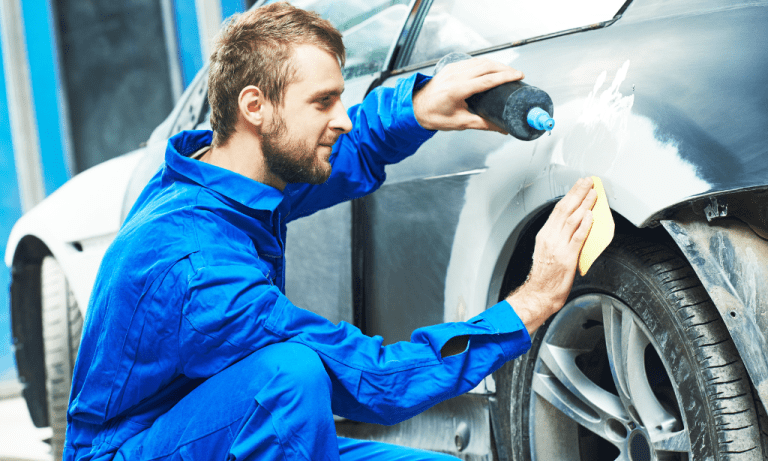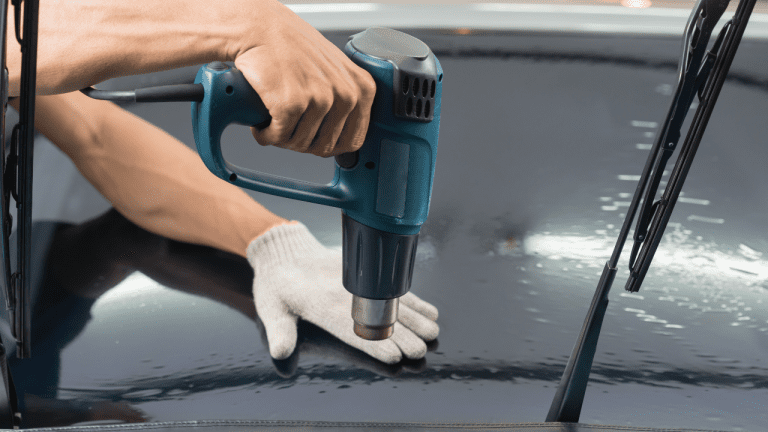Can You Paint JB Weld? (Exploring Painting Options)
JB Weld is a popular epoxy adhesive known for its exceptional strength and versatility in bonding various materials. It is commonly used for repairs in automotive, plumbing, and other household applications. One question that often arises among DIY enthusiasts and craftsmen is whether JB Weld can be painted.
Painting JB Weld is indeed possible, but it requires careful preparation and consideration of certain factors to achieve a durable and aesthetically pleasing finish. The properties of JB Weld, such as its resistance to moisture and chemicals, make it a suitable base for paint application. However, proper surface preparation, selection of compatible paint products, and following the correct painting techniques are crucial for optimal results.
In this article, we will delve into the topic of painting JB Weld and explore the steps to ensure a successful paint job. We will discuss the preparation process, suitable types of paint, and essential tips to achieve a professional-looking finish while maintaining the integrity of the JB Weld repair. Whether you’re looking to restore a metal surface or enhance the appearance of a repaired object, understanding the painting possibilities with JB Weld can be invaluable.
Is Sanding Important Before Painting Over JB Weld?
Yes, sanding is an important step before painting over JB Weld. Proper surface preparation, including sanding, helps to ensure a smooth and clean substrate for paint adhesion. Here are some reasons why sanding is necessary when painting over JB Weld:
1. Smoothing the surface
JB Weld, when cured, can have a textured or slightly rough surface. Sanding helps to level out any imperfections, bumps, or high spots, creating a smoother surface for paint application.
2. Enhancing adhesion
Sanding the surface of JB Weld creates micro-abrasions, which provide better mechanical adhesion for the paint. This roughened surface allows the paint to grip onto the JB Weld more effectively, promoting a stronger bond.
3. Removing contaminants
Sanding helps remove any contaminants like dust, dirt, or grease that may have accumulated on the JB Weld surface. A clean surface ensures better paint adhesion and prevents issues such as paint peeling or flaking.
When sanding JB Weld, use fine-grit sandpaper (around 220 to 400 grit) and sand gently in a circular or back-and-forth motion. Be cautious not to sand too aggressively, as excessive sanding may compromise the integrity of the JB Weld repair.
After sanding, make sure to thoroughly clean the surface to remove any sanding residue before proceeding with primer and paint application. This will help achieve optimal paint adhesion and ensure a smooth and durable finish over the JB Weld repair.
Why Should You Paint Over JB Weld?
Painting over JB Weld serves several important purposes:
- Aesthetics: JB Weld is often used for repairs where appearance matters, such as automotive or household applications. Painting over JB Weld allows you to achieve a finished look that matches the surrounding area, making the repair blend in seamlessly and improving the overall appearance.
- Protection: Painting provides an additional layer of protection for the JB Weld repair. It acts as a barrier against environmental factors, such as moisture, UV rays, and chemicals, which can potentially degrade the epoxy over time. Paint helps to seal the JB Weld and enhance its durability and longevity.
- Corrosion prevention: If the JB Weld repair is on a metal surface, painting can help prevent corrosion. Metal surfaces are susceptible to rust when exposed to moisture and oxygen. By painting over the JB Weld repair, you create a protective barrier that inhibits rust formation and maintains the integrity of the repaired area.
- Surface uniformity: JB Weld repairs may have a different color or texture compared to the surrounding surface. Painting over JB Weld helps achieve a uniform appearance by providing a consistent color and texture across the repaired area, making it visually cohesive.
DIY Vs. Professional Painting Services
When it comes to painting projects, whether it’s a room in your house or a piece of furniture, you have the option of choosing between a do-it-yourself (DIY) approach or hiring professional painting services. Both options have their advantages and considerations, which we’ll explore below:
DIY Painting:
1. Cost savings: DIY painting can be more budget-friendly since you won’t have to pay for professional labor. You can also choose to purchase the paint and supplies within your desired price range.
2. Flexibility and control: With a DIY project, you have complete control over the process, from selecting the paint color to determining the timeline and techniques used. You can work at your own pace and make adjustments as you see fit.
3. Learning experience: DIY painting allows you to gain valuable skills and knowledge. It can be a rewarding experience, and you’ll have the satisfaction of completing a project on your own.
4. Small-scale projects: DIY painting is well-suited for small-scale projects, such as painting a single room, a piece of furniture, or small decorative items.
Professional Painting Services:
1. Time and convenience: Hiring professionals saves you time and effort. They have the expertise and experience to efficiently complete the job, allowing you to focus on other priorities.
2. Quality and expertise: Professional painters have the necessary training and knowledge to achieve high-quality results. They have experience with various techniques, surface preparations, and paint applications, ensuring a professional and durable finish.
3. Larger or complex projects: For larger or more complex painting projects that require specialized equipment, extensive preparation, or intricate details, professional services are often the best choice.
4. Warranty and insurance: Reputable painting contractors usually provide warranties for their workmanship, giving you peace of mind. They are also insured, which protects you from liability in case of accidents or damage during the painting process.
Does JB Weld Bond To Paint?
JB Weld is primarily designed to bond to various surfaces such as metal, wood, plastic, and ceramics. While it can adhere well to these materials, its ability to bond directly to paint may be limited. JB Weld is an epoxy adhesive that forms a strong mechanical bond by creating a chemical reaction when the two components are mixed.
When it comes to bonding JB Weld to paint, it is generally recommended to apply the adhesive directly to the bare surface rather than attempting to bond it to existing paint. This is because paint can have different compositions, finishes, and levels of adhesion, which can affect the bond strength of JB Weld.
If you need to make a repair involving JB Weld on a painted surface, it is advisable to remove the paint from the repair area to ensure better adhesion. This can be done by sanding or using paint removers, depending on the type of paint and surface.
How Long Will The Paint Stick To JB Weld?
Once properly applied and cured, paint can adhere well to JB Weld. However, the longevity of the paint’s adhesion to JB Weld can depend on various factors, including surface preparation, paint quality, environmental conditions, and the specific application.
Here are some considerations regarding the longevity of paint on JB Weld:
1. Surface preparation
Properly preparing the JB Weld surface before painting is crucial for long-lasting adhesion. This typically involves cleaning the surface thoroughly, removing any contaminants, and roughening the surface through sanding or other suitable methods. A well-prepared surface promotes better paint adhesion and can contribute to the longevity of the paint.
2. Paint quality and compatibility
The type and quality of paint used can affect how well it adheres to JB Weld. It is essential to select a paint that is compatible with the surface and adheres well to epoxy materials. Consult with paint manufacturers or experts to ensure you choose the right paint for the job.
3. Environmental conditions
Environmental factors such as temperature, humidity, and exposure to UV rays can impact the longevity of paint on JB Weld. Extreme temperature fluctuations, prolonged exposure to moisture, or direct sunlight may cause the paint to degrade or peel over time. Consider using paints that are specifically formulated for exterior or high-moisture environments if needed.
4. Proper application
Following proper painting techniques, such as applying thin, even coats of paint and allowing adequate drying or curing time between coats, can contribute to the longevity of the paint on JB Weld. Additionally, ensuring that the paint is fully cured before subjecting it to harsh conditions or mechanical stress can help maintain its adhesion.
Tips On Painting Over JB Weld
When painting over JB Weld, it’s important to follow proper procedures to ensure a successful and long-lasting paint job. Here are some tips to help you achieve the best results:
1. Surface preparation
Thoroughly clean the JB Weld surface before painting. Remove any dirt, grease, or contaminants that could hinder paint adhesion. Consider lightly sanding the surface to create a slightly rough texture, which helps the paint adhere better.
2. Paint compatibility
Choose a paint that is suitable for the material you are painting over JB Weld. Check with the paint manufacturer or consult a professional to ensure compatibility with epoxy surfaces. Some paints may require a primer specifically designed for bonding to epoxy or metallic surfaces.
3. Primer application
Applying a primer can further enhance paint adhesion and provide a smooth base for the topcoat. Select a primer recommended for the specific paint type and follow the manufacturer’s instructions for application. Allow the primer to dry thoroughly before proceeding to the next step.
4. Paint application
Apply the paint in thin, even coats using a brush, roller, or sprayer, depending on the surface and desired finish. Follow the paint manufacturer’s instructions regarding application techniques, drying times, and recommended number of coats. Allow each coat to dry completely before applying the next.
5. Curing time
Give the paint sufficient time to cure before subjecting it to any stress or manipulation. Follow the paint manufacturer’s instructions for recommended curing times, which can vary depending on the type of paint and environmental conditions.
6. Maintenance and protection
Once the paint has fully cured, take care to protect the painted surface. Avoid excessive abrasion, harsh chemicals, or prolonged exposure to extreme weather conditions, as these factors can impact the longevity of the paint.
How Long Does JB Weld Take To Cure?
JB Weld typically takes about 4-6 hours to set and approximately 15-24 hours to fully cure. However, it’s important to note that the curing time can vary depending on factors such as temperature, humidity, the specific product used, and the thickness of the application.
Here are some general guidelines regarding JB Weld’s curing time:
1. Setting time
JB Weld begins to set and harden within 4-6 hours after mixing the two components together. During this time, the adhesive transitions from a liquid to a solid state. It’s important to avoid disturbing or applying stress to the repair during this initial setting period.
2. Full cure time
The full curing of JB Weld usually takes around 15-24 hours. This is the time required for the adhesive to reach its maximum strength and for all the chemical reactions to complete. It’s advisable to allow the repaired item to remain undisturbed and avoid subjecting it to heavy stress until the full cure is achieved.
3. Temperature and humidity considerations
Higher temperatures and lower humidity levels generally accelerate the curing process, while lower temperatures and higher humidity can prolong it. Follow the manufacturer’s instructions regarding temperature ranges for optimal curing results.
4. Thick applications
Thicker applications of JB Weld may require additional time to cure completely. The thickness of the repair can affect the heat generated during the curing process, which can impact the curing time. For thicker applications, it’s recommended to allow extra time for curing.
- How To Expertly Attach Patches To Headliner: Master the Process - October 3, 2023
- Can You Safely Clear Coat Your Polished Aluminum for Ultimate Shine? - October 3, 2023
- Will A Raptor Grill Fit An F150? Unveiling the Perfect Customization Option - October 3, 2023


